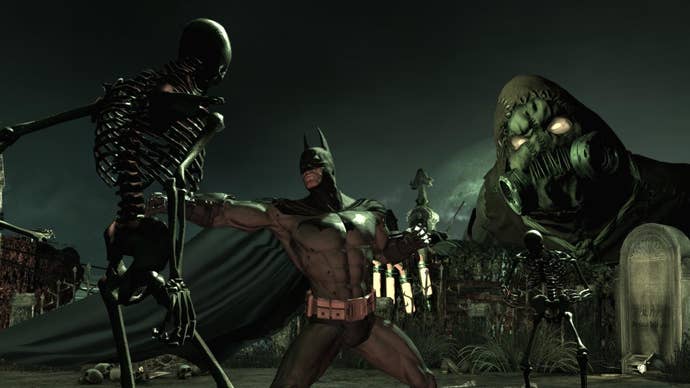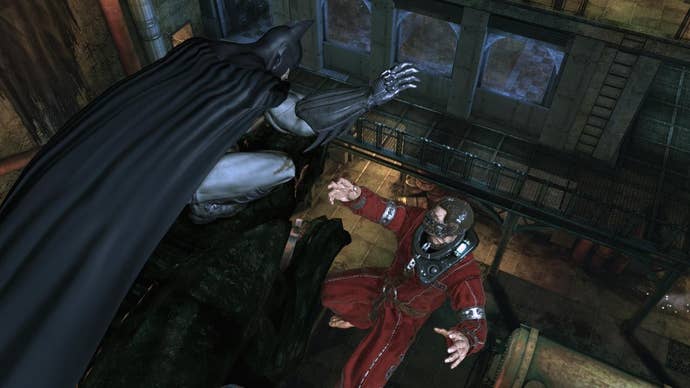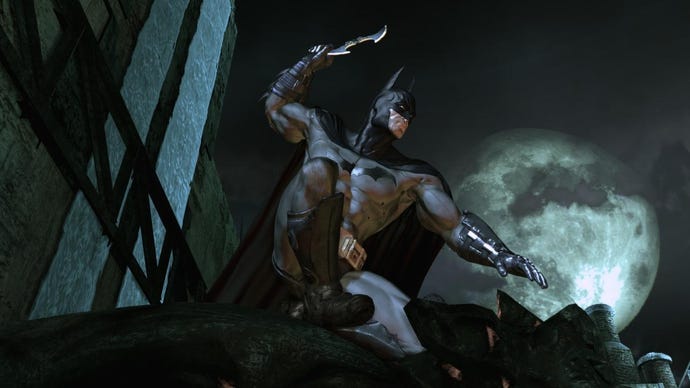Why 13 years later, Arkham Asylum is still the best Batman game
Happy Birthday! You're as old as Robin now.
The worst day of my life was at EGX about 4 years ago.
Nestled in the retro area of the exhibition hall in front of a row of black, plasticy LCD TVs sat a young boy of about 10 years old. Interested in what was passing for retro in this modern era, I hung around for a minute as the loading bar finished spinning and what I saw filled me with hollow, existential dread.
Next to the Pac-Man cabinets and CRTs with Super Mario Bros and Sonic the Hedgehog flickering on their screens, the kid wasn’t playing Arkanoid, or Asteroid, or any other -Oid, but Batman: Arkham Asylum on a PS3.
The Ark of the Covenant opened, my skin peeled off and my bones crumbled to ashen dust.
In that moment, I too had become old.
You see, Arkham Asylum wasn’t a game that I’d read about in magazines, had handed down from my Dad in the ‘90s or stupidly bought a rereleased ROM of just to be able to say I’d played. It was a game that I’d bought, completed and enjoyed in high school, and now it was sat alongside Space Invaders and other stone-age creations.
If you ever fancy scaring yourself with the relentless march of time, think back to the release of ‘your’ console - it might be the first one you bought with your own money, the one you spent the most time with as a kid or just the one you knew inside-and-out - and work out how long ago it came out.
Then, take that number and look for a world event that happened the same distance away from what you remember.
If ‘your console’ was the Nintendo 64, I have some bad news for you. Next year it will be 27 years since it first came out in 1996. And 27 years before the N64 came out, the Moon landing happened (or did it…).
My console was the PlayStation 3. I saved up for literally years to buy it at launch when I was barely a teenager and played one pretty much every day until I’d finished university. That we’re now nearly as far away from the original North American release of the PS3 as the PS3 was from the first Gameboy is a terrifying enough concept, but at least it also means we can look back with rose-tinted glasses at the plethora of brilliant games that appeared on that awesome console as the stone-cold and highly influential classics they are.
One of my favourites, Batman: Arkham Asylum, has just hit its teenage years - making it about the same age as Batman’s ward, Robin. So there’s no better time than now to mull over what made it great.
Batman: Arkham Asylum starts in typically foreboding fashion on the wet and chilly streets of Gotham City with the kind of cutscene that would be played on rails these days, as the Batmobile thunders through the gates of Arkham with a pouty Batman at the wheel and a raving Joker in the back.
Ironically, it then moves into an early example of exactly the kind of on-rails exposition I’m complaining about, where you trudge solemnly alongside NPCs whose stride and speed you can never quite match, that had started to become really trendy in blockbuster games at the time.
But that walk - as unsettling strings swell in the background - does a couple of key things that set the tone for the rest of the game.
First, it introduces you to the dream duo of Kevin Conroy as Batman and Mark Hamill - yes, that one - as Joker. A pair of great performances that perfectly nail the vibe of these versions of the two characters.
But what it also does is place you in the cape and cowl of Batman in a quieter moment where you’re both thinking the same thing: “something’s not right, what is Joker up to?”
This immediately grounds you in a deeper role play than you might be expecting, establishing the idea that you’re experiencing, making deductions and reacting to the same things as the character, figuring them out at the same time and driving their response, rather than watching a superhero story and feeling disconnected from their actions.
As things inevitably kick off, you’re smacked in the face by one of Arkham Asylum’s most lasting legacies, the third-person combat, where you flit between crowds of bad guys tapping out combos, timing dodges and reversals, and building towards special finishing moves that zoom in the camera and slow everything down so you can hear every crunch.
Obviously, Batman didn’t invent third-person brawling, but similarly to how almost every FPS has come to use Modern Warfare 2’s controller layout as the default, it defined the mainstream blueprint to such an extent that people would talk about “Batman-style” combat for years afterwards.

It was simple and empowering enough to fit the character whatever your skill level, but scalable enough to actually provide some variety encounter-to-encounter. There were guys with guns, guys with knives, big guys that could block, and all sorts of skews to take on across the game.
It was satisfying to get right and punishing to get wrong, but it could also be really annoying. However deep the roster of villains in the Batman universe, the majority of fights were always going to be against various Joker-themed goons, and visually differentiating between them in the flow of combat wasn’t always intuitive. I remember losing a lot of combos because I’d auto-locked onto a blocker that needed swishing with my cape at a moment’s notice.
While it looks a little trite these days, it still feels better executed than some games you’d say are its descendants. In Assassin’s Creed Valhalla for instance, past a certain point in your progression every single fight feels impotent because you’re so wildly overpowered. Batman: Arkham Asylum had a good balance of energy, effort and expertise.
Another place where you felt empowered, but human, is the puzzle solving and this is thanks to another of Arkham Asylum’s most influential mechanics: Detective Vision, where fantasy x-ray tech in Batman’s helmet would highlight useful information about objectives and enemies in the surrounding area.
Again, it’s not like Batman invented the idea of an in-universe overlay to point players towards key items (the aforementioned Assassin’s Creed series had its own “Eagle Vision” a couple of years earlier for instance), but it definitely advanced the concept of sleuthing around and piecing things together from your environment. It further entrenches the idea that it’s you as Batman, not just Batman, that’s the smartest person in the room - giving you an inkling into the unseen machinations that make him seem omnipotent to outsiders.
In the recent gameplay trailer for the upcoming Gotham Knights, it was interesting to see how this system has progressed and incorporated fresh ideas from other popular RPGs and it will be equally interesting to see if it’s started to feel threadbare after over a decade of dependable service.
But it’s this hidden world beneath the surface that also let Batman: Arkham Asylum be stuffed absolutely to the brim with easter eggs. One of the best things about the game is how it draws on the whole nerdy history of Batman to touch on almost every character in his monolithic canon.
I was absolutely enamoured with this at the time, because I felt like it did so much to expand what was possible with a licensed character game. It wasn’t just a cash grab like most of the stuff I was dumb enough to play on the PS2, or an arcadey beat ‘em up like the great Marvel games, but a strong concept that made proper use of the universe it was set in.
Take the first two main villains you meet outside of Joker as an example: a pre-Suicide Squad Killer Croc and Victor Zsasz. Both are relatively minor baddies, but they’re presented as if you have history together, showing you that this isn’t another origin story - you’re in the thick of the action with an established character and a huge amount of well-loved material to draw from.
It all holds up pretty well really and, even though some things like the lack of a jump button are very dated relics of that era, we’re still struggling with some of the main issues Arkham Asylum faced today.
Famously, the final boss battle, where you have a fairly standard punching match with a juiced-up Joker, was criticised as anti-climactic. But that’s a slight I could level at a slew of big-budget releases from 2022 (Dying Light 2, Horizon: Forbidden West to name just a couple).

There’s also the double-edged sword of the setting. Having everything take place over one tough night for the Caped Crusader in the same location lends the story a tight focus that you don’t get in the more expansive later additions to the series, Arkham City and Arkham Knight, with more down-time and side-quests to distract your attention.
However, it does mean that there are a lot of white-tiled corridors, the same gargoyles, and a repetitiveness that even an obligatory sewer level can’t fix.
But filling an open world with worthwhile diversions is just one of the different and difficult problems contemporary major-publisher games have to contend with. It stands to reason that Gotham Knights is built on the solid foundations of the Arkham series, and when it drops, its best parts will probably still be the same as what was great about Batman: Arkham Asylum 13 years ago.



